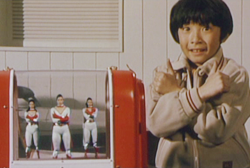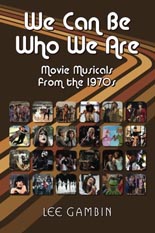 Just a Hair shy of 800 pages, We Can Be Who We Are: Movie Musicals from the 1970s is a brick. Available in hardback and paperback, the BearManor Media release by Lee Gambin is nothing if not a giant love letter to the cinema’s arguably most experimental decade of that once-sacrosanct genre. Going year by year, Gambin dives deep into each and (one assumes) every film that either is a full-fledged musical or dependent upon music; from those rated G to those rated X, he examines them with one eye toward history, one eye toward criticism and both ears toward their tunes. All the obvious titles are here, but what makes the book special is the inclusion of the lesser-knowns and obscurities, such as Son of Dracula (with Harry Nilsson and Ringo Starr), The First Nudie Musical, White Pop Jesus and assorted nuggets from the world of prime-time TV (e.g. The Paul Lynde Halloween Special). With the occasional doozy à la “Racquel Welch,” spelling is the author’s second greatest enemy, bested only by a tendency to let his interviews read as transcripts in need of a good trimming. Then again, when someone pours as much passion onto the pages as Gambin has here, I can understand his desire to impart as much here’s-what-happened knowledge as the spine glue allows.
Just a Hair shy of 800 pages, We Can Be Who We Are: Movie Musicals from the 1970s is a brick. Available in hardback and paperback, the BearManor Media release by Lee Gambin is nothing if not a giant love letter to the cinema’s arguably most experimental decade of that once-sacrosanct genre. Going year by year, Gambin dives deep into each and (one assumes) every film that either is a full-fledged musical or dependent upon music; from those rated G to those rated X, he examines them with one eye toward history, one eye toward criticism and both ears toward their tunes. All the obvious titles are here, but what makes the book special is the inclusion of the lesser-knowns and obscurities, such as Son of Dracula (with Harry Nilsson and Ringo Starr), The First Nudie Musical, White Pop Jesus and assorted nuggets from the world of prime-time TV (e.g. The Paul Lynde Halloween Special). With the occasional doozy à la “Racquel Welch,” spelling is the author’s second greatest enemy, bested only by a tendency to let his interviews read as transcripts in need of a good trimming. Then again, when someone pours as much passion onto the pages as Gambin has here, I can understand his desire to impart as much here’s-what-happened knowledge as the spine glue allows.
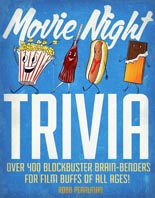 As bright and colorful as its cartoon-concessions cover, Movie Night Trivia would work as a gift to a film-loving friend, but why not you, too? Across half a dozen categories, Robb Pearlman (with true-or-false assistance from Shane Carley) has written 400 questions to test your knowledge of yesteryear’s classics, today’s blockbusters and a bunch in between. These “brain-benders” range from easy (“Name Chuck Noland’s quiet, yet faithful, friend from 2000’s Cast Away”; it’s even multiple-choice) to hard (“Name the two races that join together when The Dark Crystal is restored”) to arguably misleading/not entirely factual (“Hitting theaters between 1998’s Star Trek: Insurrection and Star Trek: Nemesis [2002], _____ is often called the best Star Trek movie ever made” — the answer is Galaxy Quest; “never made” would be playing fair). Skill level be damned, the Cider Mill Press paperback is a visual treat, with many items getting their own well-designed, full-bleed page featuring photography from the flick in question. It’d make a killer app.
As bright and colorful as its cartoon-concessions cover, Movie Night Trivia would work as a gift to a film-loving friend, but why not you, too? Across half a dozen categories, Robb Pearlman (with true-or-false assistance from Shane Carley) has written 400 questions to test your knowledge of yesteryear’s classics, today’s blockbusters and a bunch in between. These “brain-benders” range from easy (“Name Chuck Noland’s quiet, yet faithful, friend from 2000’s Cast Away”; it’s even multiple-choice) to hard (“Name the two races that join together when The Dark Crystal is restored”) to arguably misleading/not entirely factual (“Hitting theaters between 1998’s Star Trek: Insurrection and Star Trek: Nemesis [2002], _____ is often called the best Star Trek movie ever made” — the answer is Galaxy Quest; “never made” would be playing fair). Skill level be damned, the Cider Mill Press paperback is a visual treat, with many items getting their own well-designed, full-bleed page featuring photography from the flick in question. It’d make a killer app.
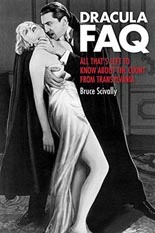 Clearly, Bruce Scivally has done his homework for Dracula FAQ: All That’s Left to Know About the Count from Transylvania. While the trade paperback touches upon the vampire’s literary roots and subsequent stage adaptations, it’s the prince of darkness’ numerous incarnations in the movies — reverent and irreverent, Universal and Hammer — that form the book’s focus. The most satisfying aspect of this is how these sections read like miniature making-of articles on the films, whether John Badham’s Dracula, Francis Ford Coppola’s Bram Stoker’s Dracula or the comedy Love at First Bite. Television runs a distant second focus, with looks at various comic books, Drac-influenced music and merchandise bringing up the rear, all illustrated with a wealth of photos and poster art. Being of the opinion that vampires don’t sparkle, I could do without the entire chapter devoted to The Twilight Saga; still, in the end, Dracula FAQ proves one of the very best entries from Backbeat Books’ ongoing FAQ line of pop-culture crash courses. Other recent titles tackle The Twilight Zone and TV finales; coming up are Rocky Horror and M*A*S*H.
Clearly, Bruce Scivally has done his homework for Dracula FAQ: All That’s Left to Know About the Count from Transylvania. While the trade paperback touches upon the vampire’s literary roots and subsequent stage adaptations, it’s the prince of darkness’ numerous incarnations in the movies — reverent and irreverent, Universal and Hammer — that form the book’s focus. The most satisfying aspect of this is how these sections read like miniature making-of articles on the films, whether John Badham’s Dracula, Francis Ford Coppola’s Bram Stoker’s Dracula or the comedy Love at First Bite. Television runs a distant second focus, with looks at various comic books, Drac-influenced music and merchandise bringing up the rear, all illustrated with a wealth of photos and poster art. Being of the opinion that vampires don’t sparkle, I could do without the entire chapter devoted to The Twilight Saga; still, in the end, Dracula FAQ proves one of the very best entries from Backbeat Books’ ongoing FAQ line of pop-culture crash courses. Other recent titles tackle The Twilight Zone and TV finales; coming up are Rocky Horror and M*A*S*H.
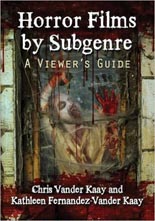 Horror Films by Subgenre: A Viewer’s Guide is a rather drab title that doesn’t exactly get the saliva flowin’. Hiding behind it, however, is a fun work of reference presented uniquely. Spouses Chris Vander Kaay and Kathleen Fernandez-Vander Kaay have chopped and divided the world of fright flicks into 75 distinct categories of That Which Scares You, whether animal attacks, environmental disasters, invisible beings, serial killers, old folks, puppets, carnivals, tools, twins — you get the idea. And if you don’t, well, therein lay the book’s purpose: introducing the reader to a very specific type of terror. Each chapter begins with a brief essay about that subgenre, followed by the meat: reviews of three or four movies that Team Vander Kaay believes are among the best representations of that subject vs. the best quality. Part of the fun of reaching each is predicting which movies they might cover; while you’re apt to guess at least one correctly, they throw in their fair share of left-field choices, too. While you could flip only to those subgenres that interest you, the McFarland & Company trade paperback is also perfectly readable as a front-to-back experience. If horror isn’t your thing, perhaps one of McFarland’s several other serious-minded film texts of the season may be: Tim Burton: Essays on the Films, A Galaxy Here and Now: Historical and Cultural Readings of Star Wars and Wizards vs. Muggles: Essays on Identity and the Harry Potter Universe, to name just three. —Rod Lott
Horror Films by Subgenre: A Viewer’s Guide is a rather drab title that doesn’t exactly get the saliva flowin’. Hiding behind it, however, is a fun work of reference presented uniquely. Spouses Chris Vander Kaay and Kathleen Fernandez-Vander Kaay have chopped and divided the world of fright flicks into 75 distinct categories of That Which Scares You, whether animal attacks, environmental disasters, invisible beings, serial killers, old folks, puppets, carnivals, tools, twins — you get the idea. And if you don’t, well, therein lay the book’s purpose: introducing the reader to a very specific type of terror. Each chapter begins with a brief essay about that subgenre, followed by the meat: reviews of three or four movies that Team Vander Kaay believes are among the best representations of that subject vs. the best quality. Part of the fun of reaching each is predicting which movies they might cover; while you’re apt to guess at least one correctly, they throw in their fair share of left-field choices, too. While you could flip only to those subgenres that interest you, the McFarland & Company trade paperback is also perfectly readable as a front-to-back experience. If horror isn’t your thing, perhaps one of McFarland’s several other serious-minded film texts of the season may be: Tim Burton: Essays on the Films, A Galaxy Here and Now: Historical and Cultural Readings of Star Wars and Wizards vs. Muggles: Essays on Identity and the Harry Potter Universe, to name just three. —Rod Lott

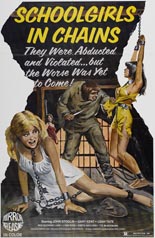
 Not much occurs in the pedestrian and paltry
Not much occurs in the pedestrian and paltry 
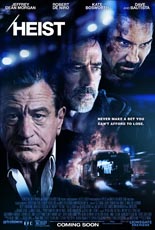
 Six long years after organizing the underrated action film
Six long years after organizing the underrated action film 
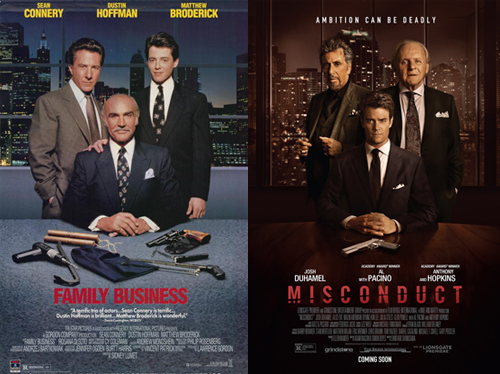
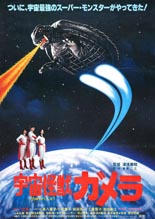
 If you see only one Gamera adventure from the Daiei studio’s initial run (not to mention outside of all those
If you see only one Gamera adventure from the Daiei studio’s initial run (not to mention outside of all those 